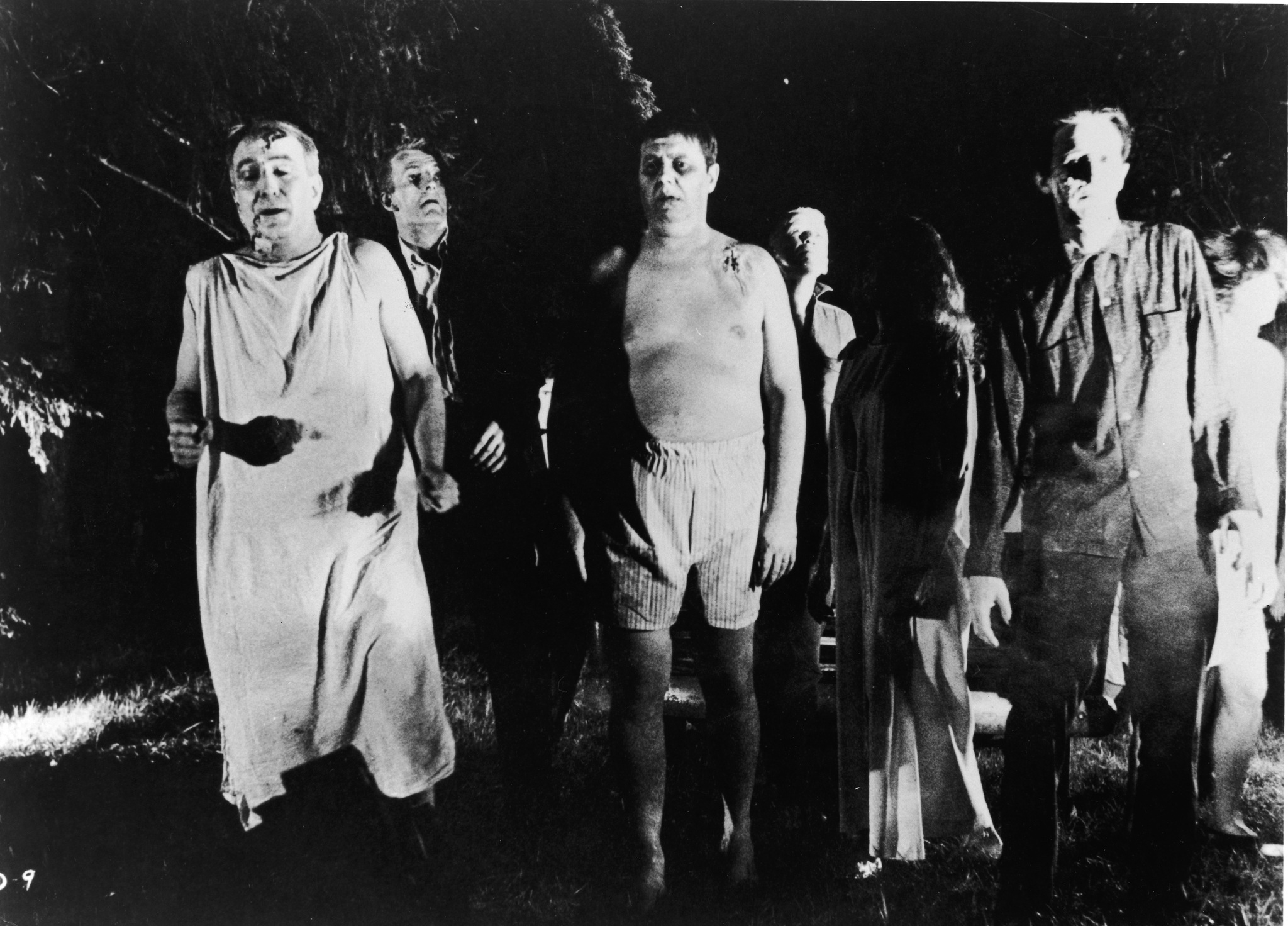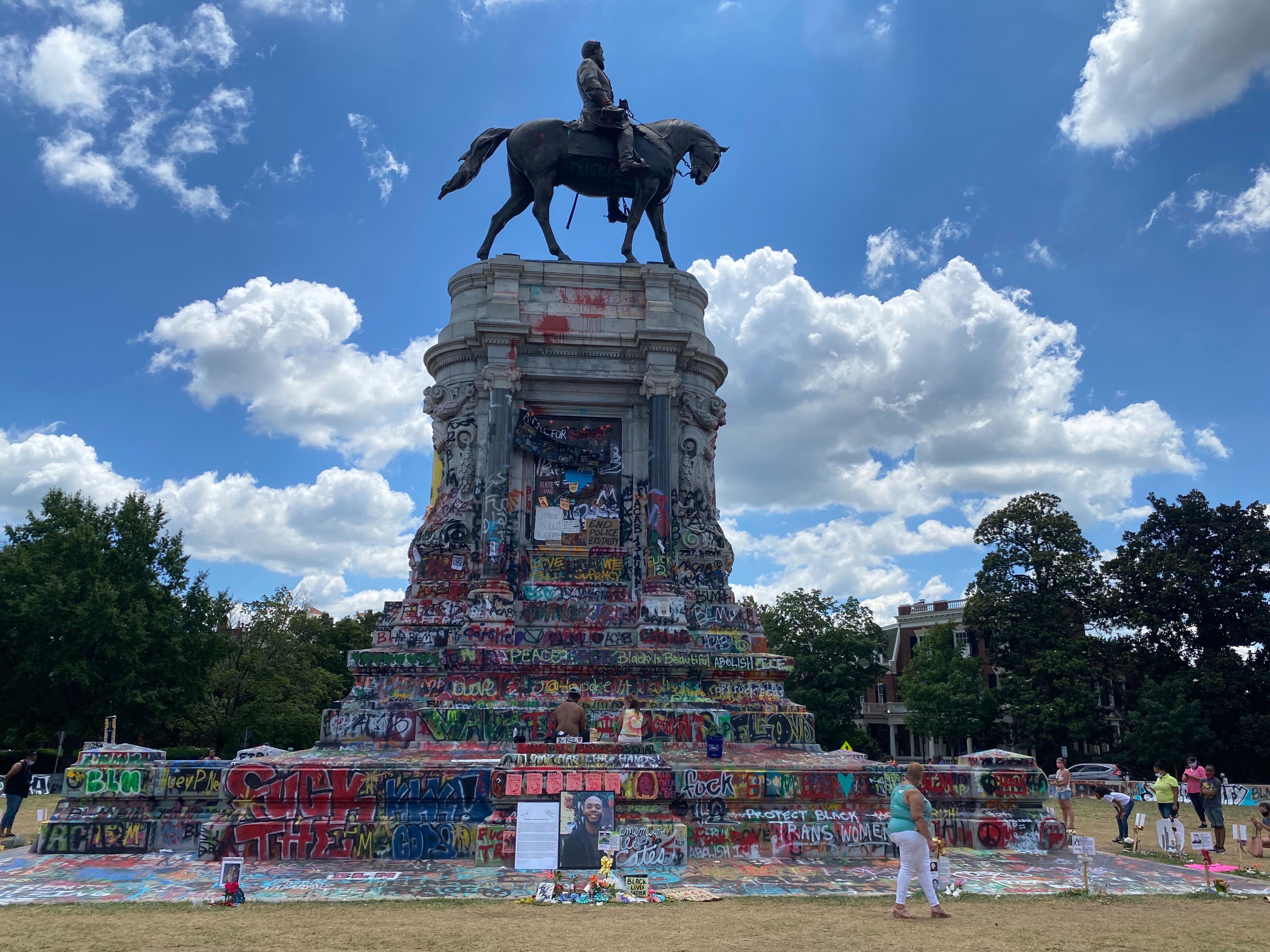This essay was originally published by Monument Lab on October 31, 2020. Since then, the monument of Robert E. Lee in Richmond was removed by the state in September 2021.
What makes a monster? How do they come into being? And when they do, by what metrics are they identified? Conventionally, they might appear gruesome. They may act on—or fail to act against—gruesome impulses. Simultaneously mundane and extraordinary, the presence of monsters provokes an uncanny familiarity. They have committed brutal acts, displayed abject depravity, and observed suffering with indifference across global histories and cultures. Yet, because they arise out of necessarily conditional logic, they defy any stable or coherent set of identifying characteristics. Like beauty, and like sadism, monstrosity is reified subjectively: it is named through the set of social relations in which it appears.
The English term “monster” has roots in two Latin verbs: monstrare, to show or reveal, and monere, to warn.1 Indeed, monstrosity’s most salient tendencies are to demonstrate societal ills and warn of their consequences, especially in times of unrest. Historically, communities have negotiated their own ethical frameworks, political allegiances, existential fears, and cultural desires through monsters. When a monster deviates from normatively privileged codes of behavior, appearance, or belief, it exposes those codes by exceeding their thresholds of tolerability. In labeling a monster, a group excludes it and steeps it in alterity, deflecting its undesired qualities away from themselves. Abusers of power weaponize monstrosity to validate acts of scapegoating, brutality, and disenfranchisement. In turn, subjugated and exploited communities monsterize their oppressors.
In recent months, monsters of all stripes have assembled themselves across a matrix of American cities, publicly voicing struggles for and against shifting vectors of power. While socioeconomic and health crises wrought by the spread of COVID-19 ballooned to catastrophically untold levels and inhibited public gatherings, massive collective uprisings altered shared landscapes, reclaiming civic spaces and dismantling monuments across the country in demands for an end to the deadly structural effects of white supremacy. The intertwining of these conditions within US systems of economic inequity stoked impassioned calls for justice through comprehensive institutional overhaul. Amidst this tumult, age-old questions of how monstrosity inheres in public life emerged anew, demonstrating deeply rooted patterns of violence and warning of their continued repercussions.
Zombie Whiteness
Prominent humanoid monsters in Gothic literary traditions (Count Dracula and the creature born in Dr. Frankenstein’s laboratory, for instance) possessed features that grotesquely exceeded human corporealities. Jack Halberstam argued that these figures served as fictional repositories for racial, sexual, class, and gender identities perceived as aberrant and threatening to white patriarchal nationhood and capitalism.2 Later narratives intervened in this genre, holding mirrors up to whiteness itself as exemplary of monstrosity, indicting how its claims to exceptionalism have metastasized around the world for centuries. These critical accounts, particularly their portrayals of white monsters publicly carrying out harmful acts, demonstrate ways in which structural and acute forms of white violence have perpetuated themselves historically.
One such account, George Romero’s Night of the Living Dead, debuted in theaters on Halloween 1968, following years of collective civil rights demonstrations across the US. A watershed for the American horror genre, the film introduced insurrectionary zombie hordes resembling middle class Americans and notably featured a Black protagonist (Ben, played by Duane Jones) in an otherwise all-white cast.3 The narrative follows Ben as he becomes the lone survivor of an overnight zombie invasion, adroitly outlasting a group hiding in a desolate farmhouse. The next morning, a cooperative of police and shotgun-bearing civilian vigilantes (with attack dogs in tow) descend on the surrounding rural landscape. They aim to exhaustively destroy everyone they believe to be a zombie—like Ben, who they spot through a farmhouse window and wrongfully identify as one of the monsters.

Having established himself as this dystopian world’s clear hero, Ben’s perfunctory and unjust loss of life summons a palpable dissonance. By the end of the film, Richard Dyer observes, the vigilantes and zombies become virtually indistinguishable, analogized by their shared whiteness and mindless resolve to kill.4 While the zombies embody murderous social insurgence, the police and their civilian accomplices implicitly justify their own deadly force in the name of “law and order.” Ben’s death puts this justification on unabashed display: one vigilante orders his murder and another callously carries it out, both in full public view of their compatriots. An aura of impunity haunts the posse’s collective acts, fortified by their self-absolution and false confidence that any body landing in their crosshairs poses a deadly threat to their schemas of “justice.” They assumed the right to kill a Black man for the sake of sustaining (white) life within and through a framework of social control.
This narrative sequence strikes an undeniable parallel with widely reported police brutality committed against civil rights activists in the years leading up to the film’s release. It also finds undeniable echoes in the violence perpetrated against racialized bodies in private homes and on public streets that both led to and continue to unfold during Black Lives Matter demonstrations of the present. More broadly, the film illuminates a complex monstrosity inveterate to whiteness: an insatiable, violent drive for self-preservation that can consume and supersede its own claims to humanity.
Powerful contemporary resonances abound in Romero’s undead cipher of the zombie, which gestures to some of white supremacy’s most abiding paradigms. For centuries, an aspiration to human disembodiment, an effacing of itself precisely in order to perpetuate itself, has served whiteness by yoking it to an imagined universal subjecthood. This Kantian notion was foundational to the framework of human development laid out in Critique of Judgement (1790), which centralized white Europeans as “subjects without properties.” These subjects could attend to high reason, per Kant, because their “unmarked” characters afforded them positionalities of disinterest.5 Enlightenment-era whiteness therefore had access to a privileged universality, existing both anywhere and nowhere, that inherently excluded “particular, marked, and raced” subjects.6 Denise Ferreira da Silva has outlined how this deployment of European whiteness as a universal intellectual and ethical gauge guided global waves of colonization, settlement, and enslavement for hundreds of years.7 As a result, vast disparities in worldwide wealth distribution have been attributed to racial and cultural difference. Ideological stabilization of these differences has enabled the ongoing “monsterizing” of countless racialized groups. In our globalized present, these cyclical operations of domination, displacement, and extraction continue to propagate themselves in utterly monstrous manifestations.
Monstrous Viralities
In April, much of the nation had been issued stay-at-home directives while confusion and panic mounted over erratic federal response to the spread of COVID-19. It was at this moment that Trump referred to the virus as a monster that “came and worked its horrible, horrible spell over the world.” His statement (like so many before and after it) constituted a rhetorical slam of what Hito Steyerl would call fascism’s “panic button for blocking off annoying remnants of reality.”8 It was a red herring delivered at a critical juncture: an attempt on behalf of the administration to disidentify with their already failed accountability by clumsily collapsing a very quantifiable threat into an abstraction purportedly beyond their control. If the novel coronavirus could be considered monstrous now, it should not be because of some phantasmic “spell.” It should be because it has laid bare the symbiotic circuitries of American capitalism and institutionalized racism in hideously novel ways.
Blueprints for these circuitries undergirded United States juridical formations at their very genesis. Racialized privilege was ratified in early American laws, which validated forceful seizure and appropriation of Black labor and Indigenous land as white property.9 Economic and legal biases structurally upholding whiteness at the expense of the lives of Black, Indigenous, and people of color have remained deeply rooted in American life. Legacies of these historical precedents have surfaced widely in the wake of COVID-19, as Latinx, Black, and Indigenous communities have suffered overtly disproportionate rates of viral infection and death.
It was amidst this unfolding crisis that demonstrations arose following the death of George Floyd in police custody. Diverse coalitions decried another crisis of public health, inextricably linked to the one wrought by the novel coronavirus: that of racism deeply embedded in American institutions of criminal justice. As protests over US law enforcement’s harassment, assault, imprisonment, and murder of Black civilians grew, so did the circulation of recorded footage showing police officers responding to these protestors with excessive force, which resulted in thousands more incidents of civilian harassment, assault, imprisonment, and multiple deaths. Public discourse quickly circulated around the need for exhaustive change to law enforcement structures at all levels, including the creation of community-supported safety organizations that could supplant conventional armed police forces and the reallocation of police budgets to fund public education, healthcare, and housing.
Where do monsters materialize here? If monstrosity’s potency can be qualified by what beliefs it reveals or what warnings it carries, then it can be identified in every corner of this far-reaching struggle. Civilians engaging in public resistance and militarized law enforcement monsterize each other. Yet, the monstrosities of whiteness’s legal and geopolitical legacies are inevitably embedded throughout these conflicts. Widely circulating images and videos of the movement have thrown these (often sublimated) monstrosities into relief, offering new ways of visualizing the workings of white supremacy endemic to American life.

A Monument, a Monster, a Break
Reflecting on Black Lives Matter protests in New York City in 2014, scholar and architect Mabel O. Wilson observed how demonstrators blocked flows of activity at municipal interchanges, such as highways and train stations. Wilson noted that by staging interventions in spaces of typically stringent civic oversight, protestors could command media attention and present “the resilient and resistant capacity of social life to the oppressive forces of capital-driven development.”10 In other words, these collective choreographies could effectively enact material inversions of systemic power relations. Through performances like “die-ins,” demonstrators signal the lethal connections between monstrous paradigms of racialized difference and the machinations of unchecked capitalism. Saidiya Hartman contends that to interject into flows of people, and thus into flows of capital, to attack and destroy capital where it lives, to riot, to loot: “these are ways of addressing the violence of that order at the level of the order—the police precinct, the retailer, the corporate headquarters.”11 Might the monument also be included in this constellation of spaces of order, suffused by histories of racism and enduringly sanctified by capital?
In its current state, the Robert E. Lee Monument in Richmond, Virginia, still stands, but in a remarkable transmutation of its original form. Its tremendous scale stymied protestors’ attempts to topple it in June. Yet, an aggregate of tags including names of those killed by police, agitational slogans, and demonstrators’ rallying cries have accumulated on it ever since. The monument’s base is now emblazoned in an arresting mosaic of color. While the statue couldn’t be felled (yet), these messages and signs remain as indexes of protestors’ and community members’ resistive acts. They trenchantly juxtapose and overwrite the monument’s original form and geosocial context. In so doing, they project new ways of seeing and new kinds of visibility for systemic inequities, disenfranchisement, and other forms of violence endorsed by the ideological apparatus that the statue lionizes. They remind us of how granite can be monstrous. Marble can be monstrous. Monuments can be monsters, too.
Legacy Russell invokes Stefano Harney and Fred Moten’s The Undercommons in her recent book Glitch Feminism when she asks, “can a break be a form of building something new? Can our breaking shit be a correction, too?”12 Spray paint, empty pedestals, and cracked, discolored concrete—signifiers of defaced, displaced, or destroyed monuments across the United States—testify to these possibilities. Their breaks gesture to spaces where newly conceivable, collectively willed political futures might arise. Where radical departures from the historical inheritances built by and for whiteness might open up. In these spaces, we might imagine what new kinds of monuments, and what new kinds of monsters, we want to see.
About Bulletin
This story is featured in the inaugural print issue of Bulletin, a public art and history print journal offering perspectives on critically reading and reimagining monuments. We collaborate with artists, scholars, curators, activists, and writers to question the symbols and systems that we have inherited—and to envision new directions and pathways for public memory.
Edited by Patricia Eunji Kim, this issue explores the theme of “Ghosts.” Contributors Charles Athanasopoulos, Jeanne Dreskin, Paul Farber, Frances Ellen Watkins Harper, Naomieh Jovin, Cannupa Hanska Luger, Shannon Mattern, Nicholas Mirzoeff, TK Smith, and Marisa Williamson consider the specters, haunting sensations, and eerie remnants of the past as they relate public art, space, and memory. Learn more and buy a physical copy of the full Bulletin today!

